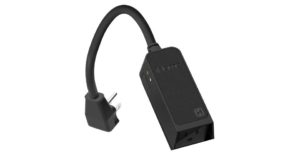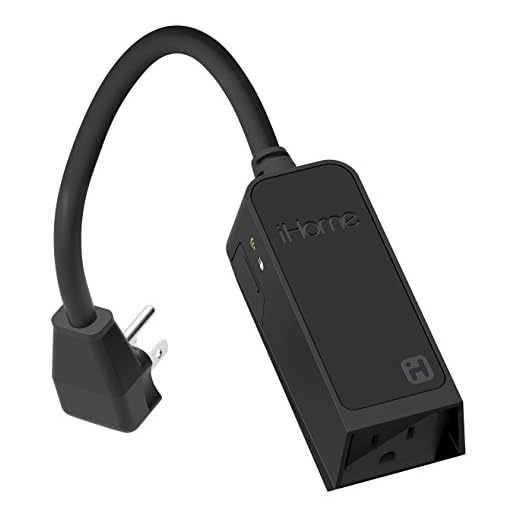Whether it’s Christmas lights, backyard fountain, or a pool pump, automating your outdoor electronics makes life a bit easier. Plus it can save you a few bucks on your electric bill. But while smart plugs seem to be popping up everywhere, not many are built to withstand the elements. That’s where the iHome iSP100 Outdoor Smart Plug comes in to play at just under $40.
The iHome iSP100 allows you to control an outlet using a smartphone or voice through Siri, Alexa, and Google Assistant. It does not require a hub and can connect to your existing Wi-Fi network (only 2.4GHz). It happens to be one of the only outdoor plugs on the market that is Apple HomeKit compatible.
Single outlet lags behind competitor designs
 A 3-prong plug extends off a plastic base via a 6 inch cord. The base measures approximately 4″ x 2″ x 2″ which makes it one of the smallest outdoor plugs we’ve reviewed. A manual power button and indicator lights (power, Wi-Fi) are situated on the side. It’s designed to fit inside a GFCI enclosed outlet with the base dangling down to avoid water getting inside. There is a small notch on top that allows for it to be mounted to the wall.
A 3-prong plug extends off a plastic base via a 6 inch cord. The base measures approximately 4″ x 2″ x 2″ which makes it one of the smallest outdoor plugs we’ve reviewed. A manual power button and indicator lights (power, Wi-Fi) are situated on the side. It’s designed to fit inside a GFCI enclosed outlet with the base dangling down to avoid water getting inside. There is a small notch on top that allows for it to be mounted to the wall.
The smaller size is due to the iSP100 having only one outlet available. This is in contrast to the iClever Outdoor Smart Plug and iDevices Outdoor Switch which have two (although iDevices can’t be controlled individually). The plug is rated to handle up to 15 amps (1800 watts). While it is not officially IP rated, iHome does state it is water resistant. Still, I would recommend sticking to a GFCI outlet if it’s going to be near water and you’ll want to avoid placing it in an area where it can get submerged.
Control remotely and customize schedules
Setting up for Apple HomeKit was a breeze. Plug in the device and add it through Apple Home by scanning the barcode. For everyone else, you’ll need the iHome app which is available for Android and iOS. This requires setting up an account and following some simple instructions to connect the plug to your WiFi. While Apple users don’t need the iHome app, it is the only way to install the latest firmware updates. You can use it for that and uninstall afterwards.
While the iHome app isn’t a favorite of mine, it was adequate enough for my needs. You can rename the device, assign it to rooms, and create specific rules. The device can be controlled remotely through the app anywhere your phone is connected to the internet. If you have other iHome products such as the indoor iHome iSP6X Smart Plug, they will show in the app as well.
The “rules” inside the app is for scheduling when to turn on and off the plug. This means you can automate it to turn on your Christmas lights at 6pm each evening and turn off at 10pm. While this feature worked great, we were disappointed to find there wasn’t an option for automating based on our area’s sunrise and sunset. There was also no energy monitoring like in the iDevices Outdoor Switch.
Overall, the plug performed well on the other side of a brick wall 25 feet from the router. There was the occasional connection hiccup, but nothing too problematic. Response time was about a second using the iHome app and instantaneous through the Apple Home app. Scheduling was reliable too. I did encounter some bugginess in the Android app.
Works with Siri, Alexa, and Google Assistant
The iHome iSP100 markets itself as one of the most compatible smart plugs on the market. It offers voice controls through Siri, Google Assistant, and Amazon Alexa. Siri was by far the easiest to set up. The other services require linking your iHome account in your Google Home or Amazon Alexa app. This needed a few attempts and wasn’t as smooth.
The only voice commands you can give is to turn on and off the plug. By renaming it in the app, you can be specific in your command (“Siri, turn on the Jack-o-Lantern”). Voice controls worked well with all three services. Siri ended up being the clear-cut winner and had the least lag and no connection issues. Alexa and Google Assistant had a tad slower response time and required occasionally “re-linking” the iHome account.
Support for Wink, Nest, and IFTTT is also available. Nest works by triggering your smart plug based on your “away mode” settings. For instance, if you want a light to automatically turn on when you leave the house, you can do so. Wink integration was a bit buggy. I didn’t do much with IFTTT as the available triggers are limited at this time.
Nice deal for Apple HomeKit users
iHome favors Apple users and their iSP100 Outdoor Smart Plug continued that trend. It was much smoother to operate through Apple HomeKit. Plus it allows you to avoid using the iHome app. So if that’s your primary use, this is a solid choice at a respectable price. Note though that for about $10 more you can get the iDevices Outdoor Switch that offers an additional outlet and energy monitoring.
If you’re not an Apple HomeKit user, I’d pass and look through our iClever Outdoor Smart Plug review. Not only is it considerably cheaper, but it provides a 2nd outlet that can be controlled independently. It was reliable and provided better protection against the elements.


